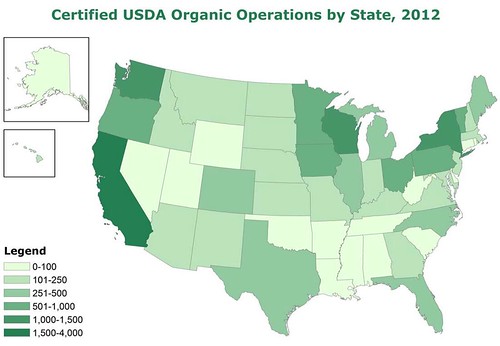
This is the eleventh installment of the Organic 101 series that explores different aspects of the USDA organic regulations.
Last week the USDA National Organic Program (NOP) published the 2012 list of certified organic operations. Our online database now provides information on 17,750 certified USDA organic farms and processing facilities in the United States. That’s almost a 240 percent increase since the NOP began tracking this data in 2002. Worldwide, there are now close to 25,000 certified organic operators representing more than 100 countries.
We provide this information to the general public, including members of the organic industry, and update it annually. Through this online tool, you can search to see whether a particular operator is certified, find certified farms and operators in a particular state, or get a list of certified operators that produce a specific organic product.
The database also provides a way to identify and connect organic stakeholders across the supply chain, providing information about organic certifiers and organic operations, including the type of certification (such as crops, livestock, or handling) and their products. The list supports the growth of the organic industry by identifying organic operations with complementary needs, and by helping people who want to start an organic business find a certifier or a certified partner to work with.

While collecting the data for the list, we found that most of the U.S. certified organic operations are on the west coast, in New England, and in the upper Midwest. In 2012, there was significant growth in the number of operations in California, Iowa, and New England. There was only slight growth in the number of operations in the southeastern United States, and there were decreases in the number of operations in part of the Midwest and some Mountain states. Internationally, since 2010, there has also been a decrease in the number of operations in areas with equivalency agreements (Canada, European Union), as operations in these countries no longer need dual certification.
The list of certified operations increases the transparency and integrity of the organic system, allowing consumers and stakeholders to search for information pertaining to organic certification. The list also improves the ability of the NOP to assess the impacts of regulatory changes by providing data on the type of operations that might be affected, and increases the NOP’s ability to oversee accredited certifiers and ensure they are consistently implementing the USDA organic regulations, by providing greater visibility into the operations that certifiers work with.
The list of certified operations, which was first release in 2009, adds greater transparency to the program and helps to increase consumer confidence in the $32 billion U.S. organic industry. We hope that you find the latest update valuable as a resource and tool.
